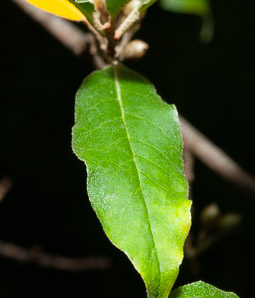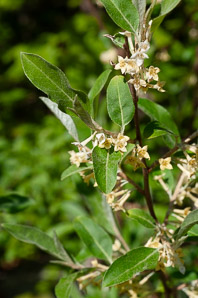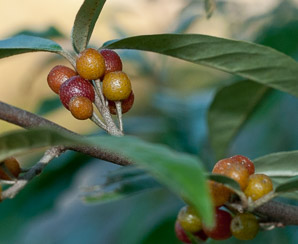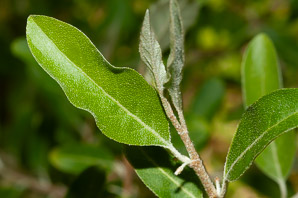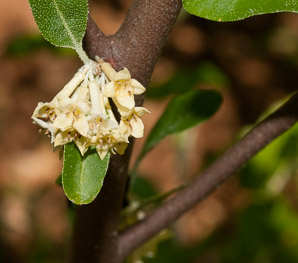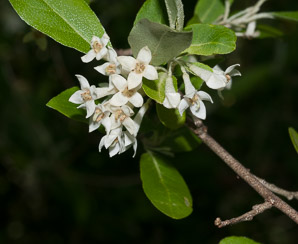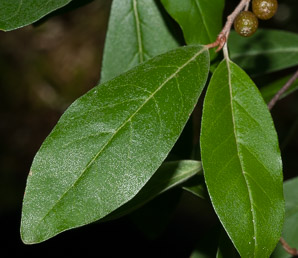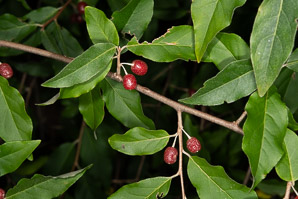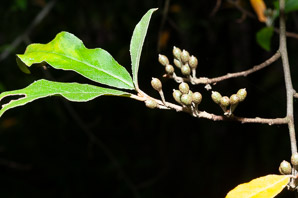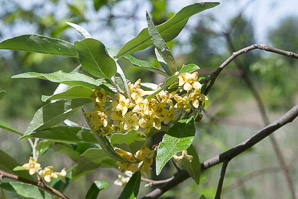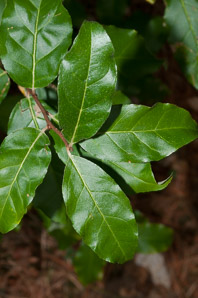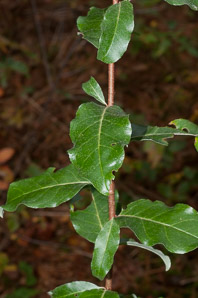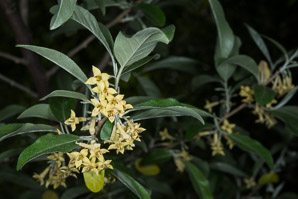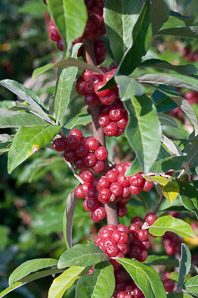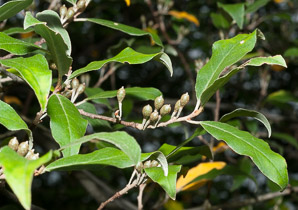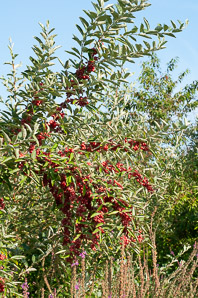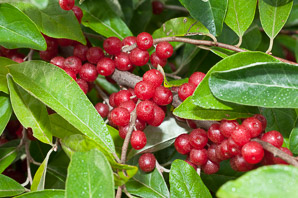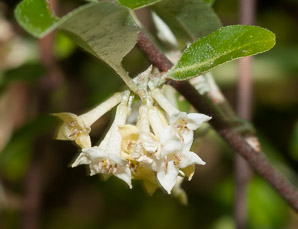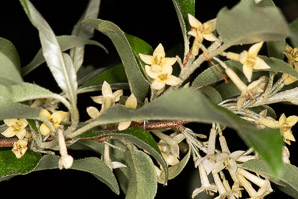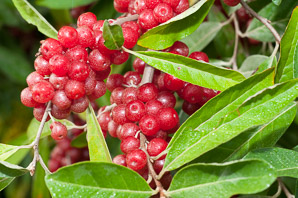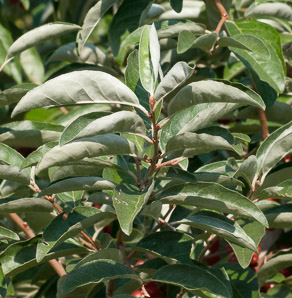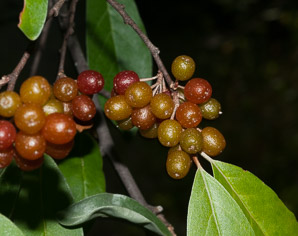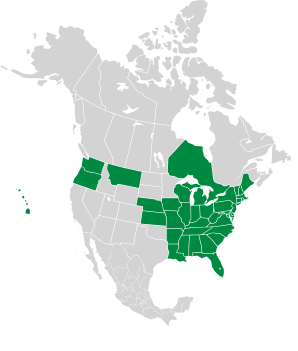
|
Elaeagnus umbellata Thunb. Autumn olive, Japanese silverberry
Autumn olive is a native of China and Japan. It is a good news/bad news plant. It was brought to North America in 1830, and planted widely for wildlife habitat, shelter belts, and mine reclamation. It spread rapidly and has become an invasive. Despite its bad rap as an invasive, it has interesting nutritional and health-related merits, described below. Identification: A large, fast-growing woody shrub or multiply branched tree, up to 20′ (6.1 m) high. Leaves are medium green on top and silvery underneath, with small dots on the underside. Branches have a few thorns. Produces small fragrant yellow flowers. This plant produces enormous numbers of red berries, each about ¼-⅜″ (6.3-9.5 mm) in diameter. The berries are speckled with brown or silvery spots, and the bottom of each berry is indented. It is found in open sunny woodlands and disturbed areas. Edibility: Fully ripe berries are tart at first, becoming sweeter, reminiscent of currants, cranberries, and peaches. The berries can be made into jams, jellies, fruit leather, or sauces. Medical: Autumn olive berries contain large amounts of lycopene, 17 times as much as are in tomatoes, our major dietary source of lycopene. Lycopene is an antioxidant which has ... generated widespread interest as a possible deterrent to heart disease and cancers of the prostate, cervix and gastrointestinal tract.[1] The berries also contain β-cryptoxanthin, another antioxidant which is converted to vitamin A in the body, and appears to suppress the likelihood of developing lung cancer.[2] Online References:
Invasive.org, Center for Invasive Species and Ecosystem Health The Southest Exotic Pest Plant Council The Virginia Tech Department of Forest Resources and Environmental Conservation The Plant Conservation Alliance’s Alien Plant Working Group Least Wanted List The USDA Forest Service's Fire Effects Information Database 8/4/2010 · Nashua River Rail Trail, Groton Center, Groton, Massachusetts · ≈ 4½ × 3″ (11 × 7.9 cm) 5/7/2010 · Tom and Susan’s, Pepperell, Massachusetts · ≈ 4 × 6″ (10 × 15 cm) 5/30/2021 · Trail near fire tower, Highland Green, Topsham, Maine · ≈ 4½ × 3″ (11 × 7.5 cm) 9/5/2010 · Nashua River Rail Trail, near Nashoba Hospital, Ayer, Massachusetts · ≈ 5 × 3½″ (13 × 9.2 cm) 5/11/2010 · Tom and Susan’s, Pepperell, Massachusetts · ≈ 4½ × 3″ (11 × 7.9 cm) 8/4/2010 · Nashua River Rail Trail, Groton Center, Groton, Massachusetts · ≈ 5 × 3½″ (13 × 9.2 cm) 5/11/2010 · Tom and Susan’s, Pepperell, Massachusetts · ≈ 4½ × 3″ (11 × 7.9 cm) 5/13/2010 · Nashua River Rail Trail, Groton Center, Groton, Massachusetts · ≈ 4½ × 3″ (11 × 7.9 cm) 8/7/2012 · Townsend Wildlife Management Area, Townsend, Massachusetts · ≈ 5 × 3½″ (13 × 9.2 cm) 8/27/2017 · Beaver Brook Conservation Area, Self-guided Nature Trail, Hollis, New Hampshire · ≈ 7 × 4½″ (18 × 12 cm) 1See this article about autumn olive 2See Wikipedia article on Cryptoxanthin
Elaeagnus umbellata description by Thomas H. Kent, last updated 11 Jul 2023. © FloraFinder.org. All rights reserved. |
8/4/2010 · Nashua River Rail Trail, Groton Center, Groton, Massachusetts · ≈ 6 × 4″ (15 × 10 cm) 5/23/2017 · Nashua River Rail Trail, Groton Center, Groton, Massachusetts · ≈ 6 × 4″ (16 × 11 cm) 10/26/2012 · Dunstable Rural Land Trust Wildlife Refuge, Dunstable, Massachusetts · ≈ 4½ × 7″ (11 × 17 cm) 10/26/2012 · Dunstable Rural Land Trust Wildlife Refuge, Dunstable, Massachusetts · ≈ 6 × 9″ (14 × 22 cm) 5/30/2014 · Townsend Wildlife Management Area, Townsend, Massachusetts · ≈ 7 × 4½″ (18 × 12 cm) 9/3/2009 · Nashua River Rail Trail, Ayer, Massachusetts · ≈ 6 × 9″ (15 × 23 cm) 8/4/2010 · Nashua River Rail Trail, Groton Center, Groton, Massachusetts · ≈ 7 × 4½″ (17 × 11 cm) 9/3/2009 · Nashua River Rail Trail, Ayer, Massachusetts 9/14/2009 · Near Nashoba Hospital, Ayer, Massachusetts · ≈ 8 × 5″ (19 × 13 cm) 5/11/2010 · Tom and Susan’s, Pepperell, Massachusetts · ≈ 4½ × 3″ (11 × 7.9 cm) 5/30/2021 · Trail near fire tower, Highland Green, Topsham, Maine · ≈ 4½ × 3″ (11 × 7.5 cm) 9/14/2009 · Near Nashoba Hospital, Ayer, Massachusetts · ≈ 7 × 4½″ (17 × 11 cm) 9/3/2009 · Nashua River Rail Trail, Ayer, Massachusetts · ≈ 1½ × 1′ (52 × 34 cm) 8/7/2012 · Townsend Wildlife Management Area, Townsend, Massachusetts · ≈ 5 × 3½″ (13 × 9.2 cm) Range:
|
